As any equestrian knows, earning your horse’s trust is essential for building a meaningful and lasting partnership.
But how to go about getting your horse to trust you is the question. With so much conflicting advice out there, where should you begin?
The truth is, gaining your horse’s trust is a process that requires patience, persistence, and a deep understanding of equine behavior.
In this comprehensive guide, we’ll walk you through a step-by-step approach to winning your horse’s trust, from decoding body language to building a bond based on mutual respect.
By the end of this post, you’ll have the knowledge and tools you need to forge a strong, trusting relationship with your equine partner.
How to Gain a Horse’s Trust: Understanding Your Horse’s Body Language
One important aspect of learning how to gain a horse’s trust is understanding their their body language and herd behavior.
Horses are incredibly expressive animals, and they communicate a great deal through their movements and postures.
By learning to read your horse’s body language, you can anticipate their needs and respond appropriately, building trust and strengthening your bond.
Recognizing Signs of Trust
As you work on understanding your horse’s body language, it’s essential to recognize the signs that your horse trusts you. Some indicators of trust include:
- Relaxed ears: When a horse’s ears are relaxed and pointed forward, it’s a sign that they feel at ease in your presence. If their ears are pinned back or swiveling erratically, they may be feeling anxious or threatened.
- A lowered head and neck: A horse that trusts you will often lower their head and neck, indicating a sense of relaxation and submission. This posture shows that they feel comfortable and safe with you.
- Soft eyes and a calm expression: Horses communicate a lot through their eyes. If their eyes are soft and relaxed, and their facial expression is calm, it suggests that they trust you.
- A willingness to approach you without hesitation: When a horse is comfortable approaching you without fear or uncertainty, it’s a clear sign that they trust you. They may even initiate contact by coming up to you in the pasture or nuzzling you affectionately.
Responding to Your Horse’s Body Language
Learning how to read your horse’s body language is vital, but it’s equally important to know how to respond to their signals. Here are some tips for reacting appropriately to your horse’s body language:
- Mirror their energy: If your horse is calm and relaxed, try to maintain a similar energy level. Avoid sudden movements or loud noises that may startle them. On the other hand, if your horse is nervous or agitated, try to project a calm and reassuring presence to help them feel more at ease.
- Be aware of your own body language: Horses are highly perceptive animals and will pick up on your emotions and body language. Make sure you’re sending the right message by maintaining a confident, relaxed posture and using gentle, consistent cues.
- Reward positive behavior: When your horse displays signs of trust, be sure to reward them with praise, gentle touches, or treats. This positive reinforcement will encourage them to continue trusting you and strengthen your bond.
- Give them space when needed: If your horse appears stressed or uncomfortable, it’s essential to respect their boundaries and give them space. Pushing them too hard or forcing interactions when they’re uneasy can damage the trust you’ve worked so hard to build.
By recognizing the signs of trust and responding appropriately to your horse’s body language, you’ll be well on your way to gaining their trust and developing a strong, lasting bond.

How to Get a Horse to Trust You: Establishing a Routine
Establishing a routine is helpful when working on getting a horse to trust you.
Horses thrive on consistency and predictability, so creating a routine can help them feel more comfortable and secure around you.
Start by establishing a regular feeding schedule and sticking to it as closely as possible.
This will help your horse learn to rely on you and trust that you will provide for their basic needs.
Consistent Grooming, Training, and Exercise
In addition to feeding, consider setting aside specific times for grooming, training, and exercise.
Make sure to vary your activities so that your horse doesn’t get bored or anxious.
When you establish a routine, you create a sense of structure and stability that can build trust over time.
Grooming as a Trust-Building Activity
Grooming is an essential part of horse care that helps to maintain a clean and healthy coat, as well as providing an opportunity for you to bond with your horse.
Make grooming a regular part of your routine, and take the time to be gentle and thorough.
This will not only help your horse feel comfortable in your presence but also allow you to observe their body condition, spot any injuries, and monitor their overall health.
Training Sessions with Clear Goals
When it comes to training, consistency is key.
Schedule regular training sessions with clear goals in mind, and ensure that you are using positive reinforcement techniques to encourage desired behaviors.
By working towards specific goals and rewarding progress, you’ll help your horse understand what is expected of them and build trust in your guidance.
Regular Exercise for Physical and Mental Wellbeing
Exercise is essential for your horse’s physical and mental wellbeing.
Set aside time each day for a variety of activities such as riding, lunging, or groundwork exercises.
Mixing up the types of exercise you engage in will help keep your horse engaged, mentally stimulated, and less likely to develop behavioral issues.
Regular exercise also allows your horse to become more comfortable with you handling them and reinforces the trust you are building.
Integrating Relaxation and Playtime
In addition to structured activities like grooming, training, and exercise, make sure to include relaxation and playtime in your routine.
This can involve simply spending time with your horse in their pasture or engaging in activities like hand-walking or playing with toys.
By incorporating downtime into your routine, you’ll help create a balanced and low-stress environment, which is essential for developing a trusting relationship with your horse.
By consistently integrating these elements into your routine – regular feeding, grooming, training, exercise, and relaxation – you’ll create a stable and predictable environment that fosters trust and strengthens the bond between you and your horse. This consistency is key when learning how to get a horse to trust you, as it demonstrates that you are a reliable and caring partner.
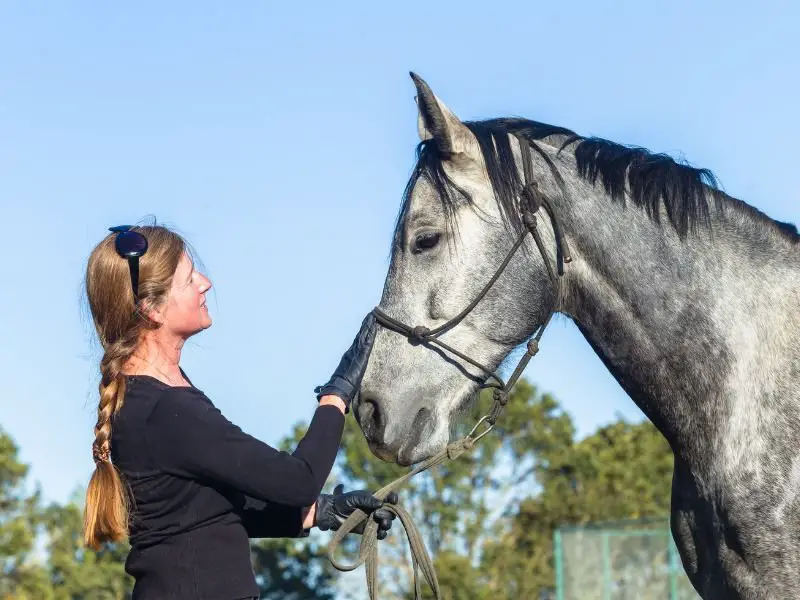
How to Get a Spooky Horse to Trust You: Building Confidence
Spooky horses can be particularly challenging to build trust with, as they tend to be more sensitive and reactive to their surroundings.
To learn how to get a spooky horse to trust you, it’s essential to help them build confidence and feel secure in their environment.
Desensitization Training
Desensitization training involves gradually exposing your horse to new stimuli, such as objects, sounds, or situations, in a controlled and positive manner.
This helps your horse become more comfortable and less reactive to these stimuli over time. Some techniques for desensitization training include:
- Introducing new objects slowly and calmly, allowing your horse to investigate at their own pace
- Rewarding your horse with treats, praise, or affection for remaining calm and curious
- Gradually increasing the level of difficulty, always ensuring your horse feels safe and comfortable
Establishing a Calm and Consistent Environment
Creating a calm and consistent environment for your spooky horse is crucial to building trust.
Ensure their living space is clean, well-organized, and free from sudden noises or distractions.
Additionally, maintaining a consistent routine, as mentioned earlier in the article, will help your horse feel more secure and predictable in their daily life.
Working with a Professional Trainer
If you’re struggling with how to get a spooky horse to trust you, consider working with a professional trainer experienced in working with sensitive or nervous horses.
They can provide valuable guidance and insights to help you better understand and work with your horse’s unique temperament and needs.
Patience and Empathy
Patience and empathy are essential when working with a spooky horse.
It’s important to remember that these horses may require more time and effort to build trust, and pushing them too hard or too fast can backfire.
Always approach your horse with understanding and be willing to adjust your methods as needed to suit their individual needs and progress.
Building Trust through Positive Experiences
As you work on desensitization training and establishing a calm environment, focus on creating positive experiences for your horse.
Reward them for their bravery and progress, and avoid situations that may trigger fear or anxiety.
Over time, your spooky horse will begin to associate you with safety, comfort, and positive experiences, which will help build a strong foundation of trust.
Gaining the trust of a spooky horse requires patience, understanding, and a tailored approach that helps them feel safe and secure in their environment. By implementing desensitization training, maintaining a calm environment, working with a professional trainer if needed, and focusing on positive experiences, you can help your spooky horse build confidence and trust in you as their handler.
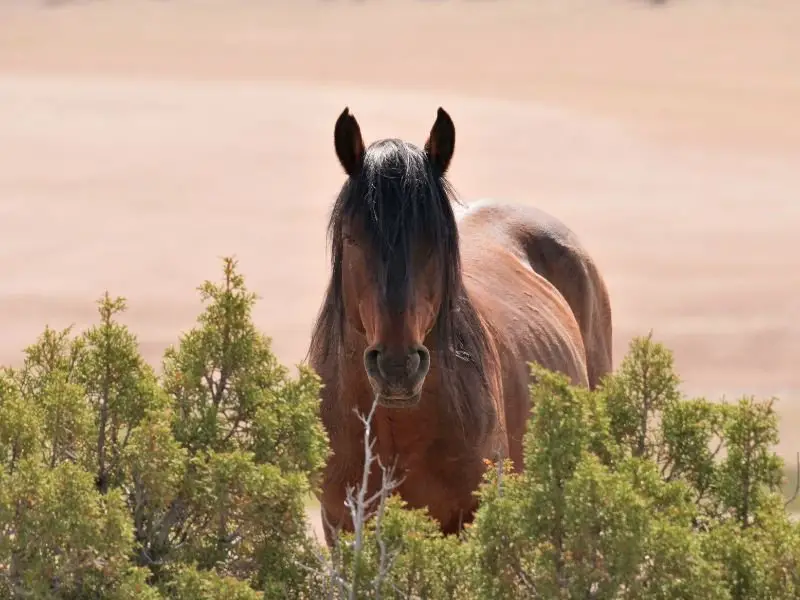
How to Get a Wild Horse to Trust You: Patience and Respect
Working with a wild horse presents unique challenges, as they may be fearful of humans and unaccustomed to being handled.
Learning how to get a wild horse to trust you requires patience, respect, and a gentle approach.
Building Trust Gradually
When working with a wild horse, it’s crucial to build trust gradually and give the horse time to acclimate to your presence.
Some steps you can follow include:
- Spending time in the horse’s environment: Allow them to observe you from a distance, showing them that you are not a threat. This will help the horse become more comfortable with your presence.
- Gradually decreasing the distance: As the horse becomes more familiar with you, slowly decrease the distance between you and the horse, always respecting their personal space. This process may take several days or even weeks, depending on the horse’s temperament and previous experiences.
- Offering food or treats: Present treats from your hand, allowing the horse to approach you on their own terms. This can help establish a positive association between you and the horse and encourage them to trust you more.
- Slowly introducing touch: Start with gentle strokes on the neck and shoulders, being mindful of the horse’s reactions. If the horse shows signs of discomfort, stop and give them space. Gradually progress to other areas of the body, always being gentle and patient.
- Introducing the halter: Once the horse is comfortable with your touch, you can begin to introduce the halter. This should be done slowly and carefully, allowing the horse to become familiar with the sensation of having a halter on their head.
- Leading and groundwork: With the halter in place, begin to practice leading and basic groundwork exercises. This will help establish your leadership role and deepen the bond between you and the horse.
Remember, building trust with a wild horse can take longer than with a domesticated horse, so patience is key.
By following these steps and consistently demonstrating your respect for the horse’s boundaries and needs, you can gradually build a trusting relationship with a wild horse.
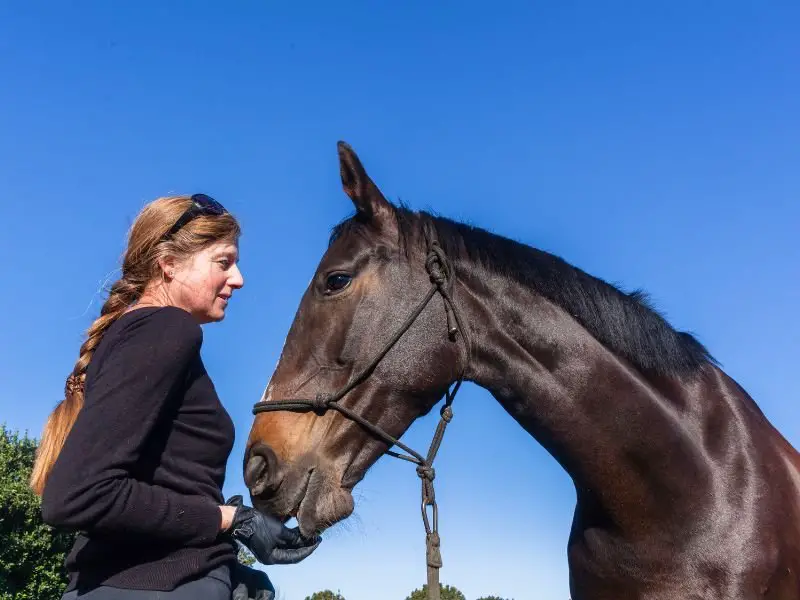
How to Earn a Horse’s Trust: Training with Positive Reinforcement
Once you have established a routine and built some initial trust, it’s time to learn how to earn a horse’s trust through training with positive reinforcement.
This powerful tool is essential for fostering trust and strengthening your bond with your equine companion.
A consistent routine will help your horse understand what is expected of them, and positive reinforcement can reward them for good behavior.
Rewarding Desired Behaviors
Using positive reinforcement means rewarding your horse for desired behaviors.
Some effective ways to reward your horse include treats, praise, and affection.
Be sure to use these rewards immediately after the desired behavior occurs to help your horse make the connection between their behavior and the reward.
Setting Clear and Achievable Goals
When training your horse with positive reinforcement, it’s important to set clear and achievable goals.
Break down complex tasks into smaller, more manageable steps that your horse can understand and master.
This will help your horse build confidence and trust in you as they experience success in their training.
Consistency is Key
Consistency is crucial when it comes to training with positive reinforcement.
Ensure that you use the same cues and rewards for each behavior consistently so that your horse can easily understand what you’re asking of them.
Inconsistent training can confuse your horse and may hinder the trust-building process.
Encouraging a Spooky or Wild Horse
Learning how to get a spooky horse to trust you or how to get a wild horse to trust you can be particularly challenging.
These horses may be more sensitive, fearful, or reactive to stimuli.
It’s essential to proceed with caution, patience, and understanding when working with these horses.
Start by introducing yourself and your presence gradually, allowing them to become familiar with you over time.
Observe their reactions and adapt your approach accordingly.
When they show signs of relaxation and acceptance, begin rewarding them for positive interactions and behaviors.
Focusing on Positive Experiences
It’s essential to focus on rewarding good behavior rather than punishing bad behavior.
Punishment can damage the trust between you and your horse, while positive reinforcement reinforces positive behavior and helps build your horse’s trust.
By creating positive experiences for your horse during training sessions, you’ll be encouraging them to trust you and respond positively to your cues.
Building Confidence Over Time
As you consistently use positive reinforcement during your training sessions, your horse will begin to develop confidence in both themselves and you.
This confidence is crucial for building trust and enhancing your relationship.
Remember, the process of earning a horse’s trust takes time and effort, but the outcome is a strong, lifelong bond between you and your equine companion.
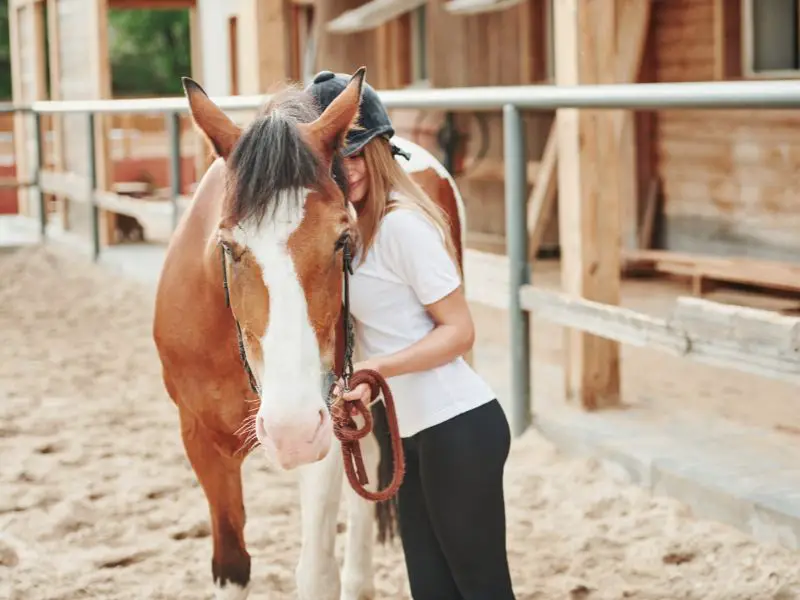
How to Gain Trust with a Horse: Spending Quality Time Together
Spending quality time with your horse is crucial for developing a strong bond and trust between you and your equine companion. Whether it’s taking peaceful walks, grooming sessions, or just hanging out in the pasture, these moments of connection will enhance your horse’s sense of security and wellbeing.
Creating Positive Experiences
Remember to avoid any activities that might trigger fear or discomfort in your horse, as this will only undermine your efforts to build trust.
Instead, focus on creating positive experiences that your horse will enjoy and appreciate.
Here are some suggestions for positive activities you can engage in with your horse:
- Grooming: Regular grooming sessions not only help to keep your horse clean and healthy but also allow for a hands-on bonding experience. Be gentle and thorough, paying attention to your horse’s reactions to your touch.
- Hand grazing: Take your horse out for a leisurely stroll, allowing them to graze on fresh grass or leaves. This can be a relaxing and enjoyable experience for both you and your horse, fostering trust as they learn to associate you with pleasant experiences.
- Groundwork exercises: Working with your horse on the ground can help build trust and understanding between the two of you. Simple exercises, such as leading your horse, asking them to back up or move their hips, can help establish a solid foundation of communication and respect.
- Leisurely rides: Going for slow, relaxed rides can be a great way to spend quality time with your horse. Choose a calm environment and take the time to appreciate the scenery and your horse’s company.
- Massage and stretching: Providing your horse with gentle massages and stretches can help alleviate tension and stress, while also promoting relaxation and trust. Be mindful of your horse’s reactions and adjust your pressure and technique accordingly.

Developing a Deeper Understanding
As you spend more time with your horse, you’ll develop a deeper understanding of their personality, preferences, and communication style. This will help you to respond more effectively to their needs and build a mutually respectful relationship that is based on trust, patience, and kindness.
To achieve this, consider the following tips:
- Observe your horse’s behavior: Pay attention to how your horse interacts with other horses, people, and their environment. This will give you valuable insights into their likes, dislikes, and overall temperament.
- Learn to read your horse’s body language: Horses communicate a great deal through their body language. Recognizing the subtle cues your horse is giving you will help you understand their emotions and needs, allowing you to respond accordingly.
- Develop a consistent routine: As mentioned earlier, a consistent routine helps create a sense of stability and trust. Make sure to incorporate quality time into your daily schedule, so your horse knows when to expect your presence and attention.
- Be patient and understanding: Building trust takes time and effort, so be patient with your horse and yourself. Recognize that trust-building is a process, and setbacks may occur. Maintain a positive attitude, and keep working on your bond.
By creating positive experiences and developing a deeper understanding of your horse, you can create a strong foundation of trust that will lead to a lifelong bond between you and your equine companion.
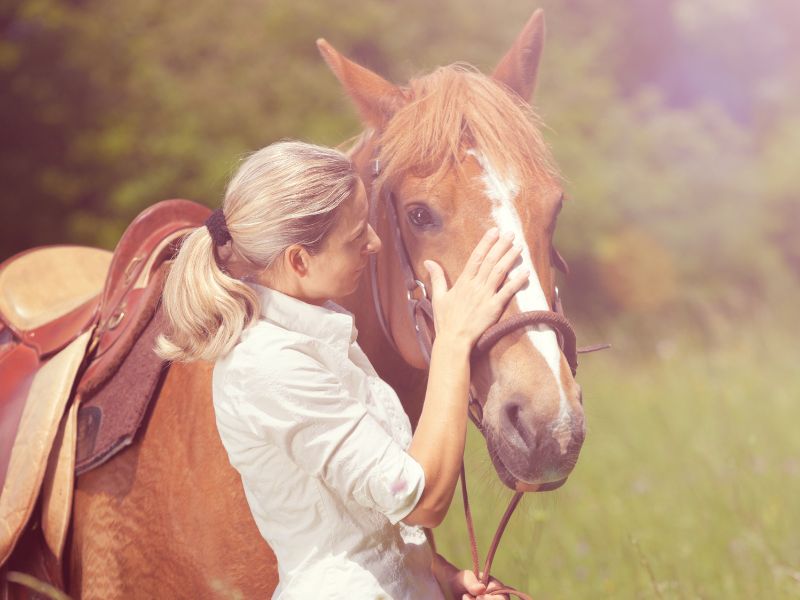
Building a Bond through Mutual Respect
Developing a bond with your horse that is rooted in mutual respect is essential for a successful relationship.
As you spend more time with your horse, you’ll gain a deeper understanding of their unique personality, preferences, and communication style, enabling you to respond more effectively to their needs.
With a foundation of trust and positive reinforcement established, it’s time to explore the different aspects of building a strong bond through mutual respect.
Listening to Your Horse
To cultivate a relationship built on mutual respect, it’s crucial to truly listen to your horse.
Horses are intelligent beings with distinct personalities, and they communicate with us in their own unique ways.
By attentively observing your horse’s body language and behavior, you can understand their needs and respond accordingly.
Make a conscious effort to observe and listen to your horse, rather than imposing your own ideas or expectations on them.
Avoiding Force or Dominance
A key aspect of building mutual respect with your horse is avoiding the use of force or dominance in your interactions. Instead, concentrate on positive reinforcement and reward-based training methods.
This approach will help your horse feel safe, comfortable, and content in your presence, which is essential for establishing a strong bond based on trust and respect.
Encouraging Confidence and Independence
Building a bond of mutual respect also involves encouraging your horse’s confidence and independence.
Providing your horse with opportunities to make choices and express their preferences can foster a sense of autonomy and self-assurance.
For example, you can offer different types of treats or toys and observe which ones your horse prefers.
This approach not only strengthens the bond between you and your horse but also helps create a more fulfilling partnership for both of you.
Respecting Boundaries
It’s essential to recognize and respect your horse’s boundaries in order to maintain a relationship based on mutual respect.
Just like humans, horses have personal space and comfort zones that must be respected.
By paying attention to your horse’s body language and reactions, you can identify their boundaries and ensure you don’t inadvertently push them too far.
This awareness and respect for your horse’s limits will strengthen the trust and respect between you.
Cultivating Patience and Understanding
Patience and understanding are vital components of building a bond through mutual respect.
Recognize that your horse may have had previous experiences that influence their behavior and reactions.
By demonstrating patience and empathy, you can help your horse overcome any past traumas or negative associations.
This nurturing approach will create a more harmonious and trusting relationship, laying the foundation for a long-lasting partnership.
By focusing on these key aspects – listening to your horse, avoiding force or dominance, encouraging confidence and independence, respecting boundaries, and cultivating patience and understanding – you’ll foster a bond with your horse that is rooted in mutual respect. This strong bond will ultimately lead to a more rewarding and satisfying relationship for both you and your equine companion.

Staying Patient and Persistent
Building a deep and lasting relationship with your horse is an ongoing journey that requires patience, persistence, and commitment.
As you work on building mutual respect and trust, remember that this process takes time, and it is important to remain dedicated and open to learning from your horse.
By staying the course, you will gradually develop a bond based on mutual respect that will last a lifetime.
Embracing the Journey
- Setting realistic expectations: Understand that building a strong bond with your horse won’t happen overnight. Just as with human relationships, trust and understanding take time to develop. Keep your expectations realistic and be patient as you progress through each stage of your relationship with your horse.
- Recognizing small victories: As you work on building trust with your horse, it’s essential to celebrate the small victories along the way. Recognizing and appreciating the incremental progress you make will help keep you motivated and foster a positive mindset.
- Adjusting your approach: It’s important to be adaptable and willing to adjust your approach based on your horse’s needs, personality, and progress. Being flexible and responsive to your horse’s individual needs will contribute to a more positive and productive experience for both of you.
Maintaining a Positive Mindset
- Managing your emotions: Horses are highly sensitive to human emotions, so it’s important to manage your own feelings and maintain a calm, positive demeanor when working with your horse. If you’re feeling frustrated, take a break and resume the session later when you’re in a better emotional state.
- Focusing on progress, not perfection: Keep in mind that the goal is progress, not perfection. Celebrate your horse’s achievements, no matter how small, and remember that setbacks are a natural part of the learning process.
- Practicing patience: Building trust with your horse takes time, and it’s crucial to practice patience throughout the process. Remember that you are both learning from each other, and be compassionate towards yourself and your horse.
Learning from Each Other
- Being open to feedback: Listen to what your horse is trying to communicate through their body language and behavior. Be open to learning from your horse and adjusting your approach based on their feedback.
- Developing empathy: Developing empathy for your horse means understanding their emotions, needs, and fears. By putting yourself in their shoes, you’ll be better equipped to understand and respond to their needs, ultimately building a stronger bond.
- Growing together: Recognize that building trust with your horse is a two-way street. You and your horse will learn and grow together throughout the process. By staying open to learning from each other, you’ll be better equipped to create a lasting, trusting relationship.
Patience and persistence are essential when working to build a lasting bond with your horse. Embrace the journey, maintain a positive mindset, and be open to learning from each other. With time and dedication, you’ll foster a deep, mutual trust and respect that will form the foundation of your lifelong partnership with your equine companion.
Conclusion
In conclusion, gaining your horse’s trust requires time, effort, and a deep understanding of their needs and behaviors.
By following the steps outlined in this guide you can cultivate a strong bond with your equine companion:
- understanding body language
- establishing a routine
- positive reinforcement training
- spending quality time
- building mutual respect
- staying patient
Always remember to approach your interactions with your horse with:
- patience
- positivity
- respect
As you put these principles into practice, your horse will come to see you as a trusted and reliable partner. Keep working at it, and you’ll be rewarded with a partnership built on trust and mutual respect.
As the saying goes, “A horse is the projection of people’s dreams about themselves – strong, powerful, beautiful – and it has the capability of giving us escape from our mundane existence.”
So go ahead, make those dreams a reality, and build a bond with your horse that will last a lifetime.
By following these steps and showing patience and consistency, you can earn the trust of your horse and build a strong bond together.
Cheers, Kacey
P.S. Did you like this article? Gallop over to:

